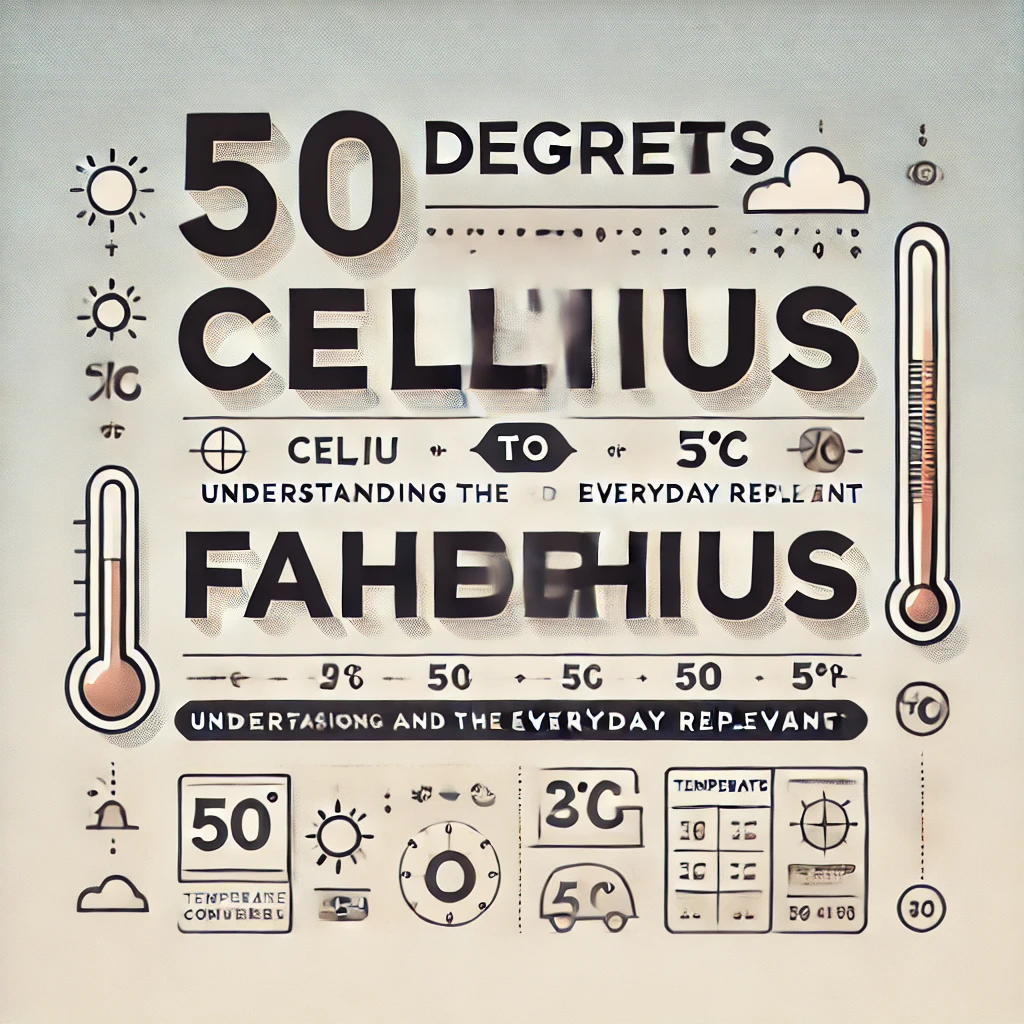Temperature conversions can be tricky, especially when you’re trying to convert Celsius (°C) to Fahrenheit (°F) or vice versa. One of the most common temperature conversions people search for is “50 degrees C to F.” Whether you’re planning a trip, cooking, or simply trying to understand the weather, it’s essential to know how to convert temperatures.
In this blog post, we’ll explore how to convert 50 degrees Celsius to Fahrenheit, why this conversion is important, and how it relates to everyday life. Along the way, we’ll provide helpful tips, easy explanations, and even some fun facts about temperature!
What Is 50 Degrees Celsius in Fahrenheit?
Let’s cut straight to the chase. The formula for converting Celsius to Fahrenheit is:
F = (C × 9/5) + 32
Using this formula, let’s plug in 50 degrees Celsius to see what we get:
F = (50 × 9/5) + 32
F = (450/5) + 32
F = 90 + 32
F = 122°F
So, 50 degrees Celsius equals 122 degrees Fahrenheit. That’s quite hot, isn’t it? To put it into perspective, this temperature is about the same as a scorching summer day in some of the hottest deserts in the world!
Why Convert Celsius to Fahrenheit?
You might wonder, “Why do I need to know how to convert Celsius to Fahrenheit?” Well, there are several reasons why temperature conversions are handy in daily life:
- Traveling: If you’re traveling to a country that uses Celsius (like most of the world), it’s useful to know how to convert temperatures to Fahrenheit, especially if you’re used to the Fahrenheit system.
- Cooking: Many international recipes provide temperatures in Celsius, and if your oven uses Fahrenheit, understanding this conversion will help you bake or cook with ease.
- Weather: Understanding the weather in different countries becomes easier when you know how to convert Celsius to Fahrenheit, so you can pack the right clothes or know what to expect.
The Science Behind the Conversion

You might be curious why the Celsius and Fahrenheit scales are different in the first place. Well, Celsius is based on the freezing (0°C) and boiling points (100°C) of water, which makes it quite practical for scientific measurements. Fahrenheit, on the other hand, was developed by Daniel Fahrenheit and is more tailored to human experiences of temperature. For example, 0°F was chosen as the temperature of a brine solution, and 100°F was roughly the body temperature of a person.
Though most of the world uses Celsius, Fahrenheit remains in use in the United States, and it’s important to know how to switch between the two.
How Hot Is 50 Degrees Celsius?
Now that we know that 50°C is 122°F, let’s look at how hot that actually is. Here are some real-world comparisons:
- 50°C is similar to the temperature in some of the hottest deserts on Earth, like Death Valley in California or the Sahara Desert.
- At 50°C, asphalt can become dangerously hot, potentially burning the soles of your shoes or causing skin burns if touched.
- Many people wouldn’t survive prolonged exposure to 50°C without air conditioning or shade. It’s a temperature extreme that can lead to heat exhaustion or heat stroke.
Tips for Converting Celsius to Fahrenheit (Without a Calculator!)
While it’s always easy to whip out your smartphone and type “50 degrees C to F” into Google, there are some quick tricks to make the conversion in your head:
- Double the Celsius number: Start by doubling the Celsius temperature. So, for 50°C, that would be 100.
- Add 30: Now, add 30 to the doubled number. 100 + 30 = 130.
- Adjust slightly: This gives you an estimate close to the actual temperature (in this case, 122°F). It’s a handy trick when you need a rough estimate!
Everyday Temperatures in Celsius and Fahrenheit
Understanding how 50°C compares to other everyday temperatures can also be useful. Here are some temperature benchmarks to give you a sense of scale:
- 0°C (32°F): The freezing point of water. Pretty cold, right?
- 20°C (68°F): Room temperature or a mild spring day.
- 30°C (86°F): A warm summer day, ideal for the beach.
- 40°C (104°F): Getting really hot – think heatwave conditions.
- 50°C (122°F): Extreme heat, as we’ve discussed!
Using Online Tools for Quick Conversions
If you’re someone who frequently needs to convert between Celsius and Fahrenheit, it might be worth bookmarking an online converter or downloading an app. These tools make it effortless to switch between temperature units with just a few taps or clicks.
For those who enjoy math or are just curious, understanding the conversion formula can be a fun way to keep your brain sharp. After all, who doesn’t love a little mental workout?
Why Both Scales Matter
You might wonder why some places use Celsius and others use Fahrenheit. Celsius is primarily used in science because it’s easier to relate to the metric system, which is used globally in most scientific and engineering fields. Meanwhile, Fahrenheit is still popular in everyday use in the United States.
Both temperature scales have their advantages, and it’s always good to be familiar with both when you’re navigating different regions or working on international projects.
Conclusion: Why Temperature Conversions Matter
Converting temperatures, such as 50 degrees Celsius to Fahrenheit, is more than just a math exercise. It’s a practical skill that can help you when traveling, cooking, or even staying safe during extreme weather conditions. Knowing that 50°C equals 122°F gives you a clear picture of how hot it really is and why it’s essential to be cautious in such extreme heat.
FAQs
1. What is 50 degrees Celsius in Fahrenheit?
50 degrees Celsius is 122 degrees Fahrenheit.
2. Is 50°C too hot for humans?
Yes, prolonged exposure to 50°C can be dangerous and potentially life-threatening. It’s essential to stay hydrated, seek shade, and avoid direct sunlight in such extreme heat.
3. Why is Fahrenheit still used in the United States?
Fahrenheit is a legacy system in the U.S. It’s widely used in everyday life, particularly for weather reports and cooking, even though Celsius is the standard in most other countries.
4. How do I quickly convert Celsius to Fahrenheit?
A simple trick is to double the Celsius temperature and add 30 for a rough estimate. For example, 50°C becomes roughly 130°F.
5. What’s hotter: 50°C or 122°F?
They are the same! 50°C is equivalent to 122°F.
By understanding how to convert between these two scales, you’ll always be prepared—whether you’re checking the weather, cooking, or traveling around the globe!








